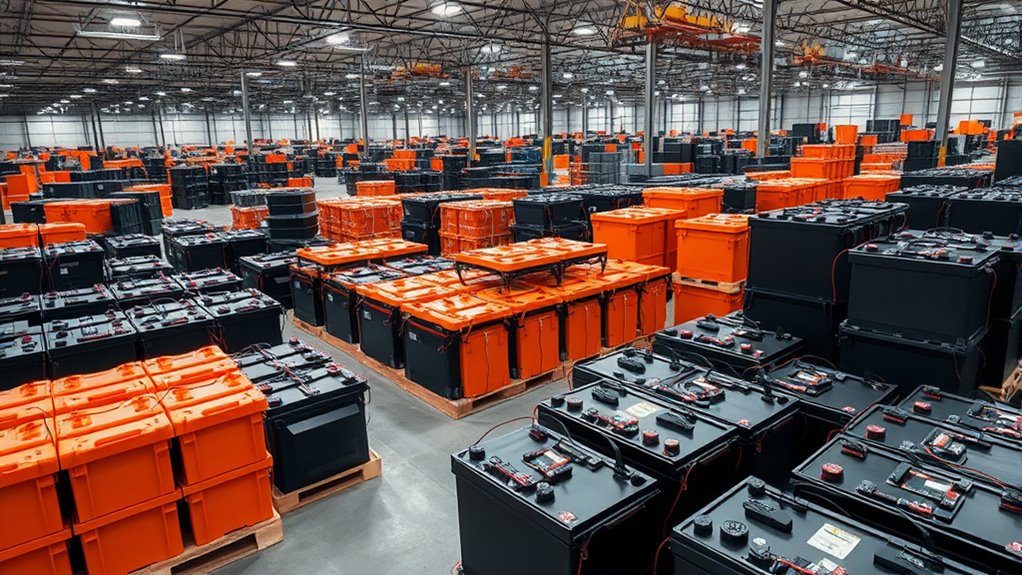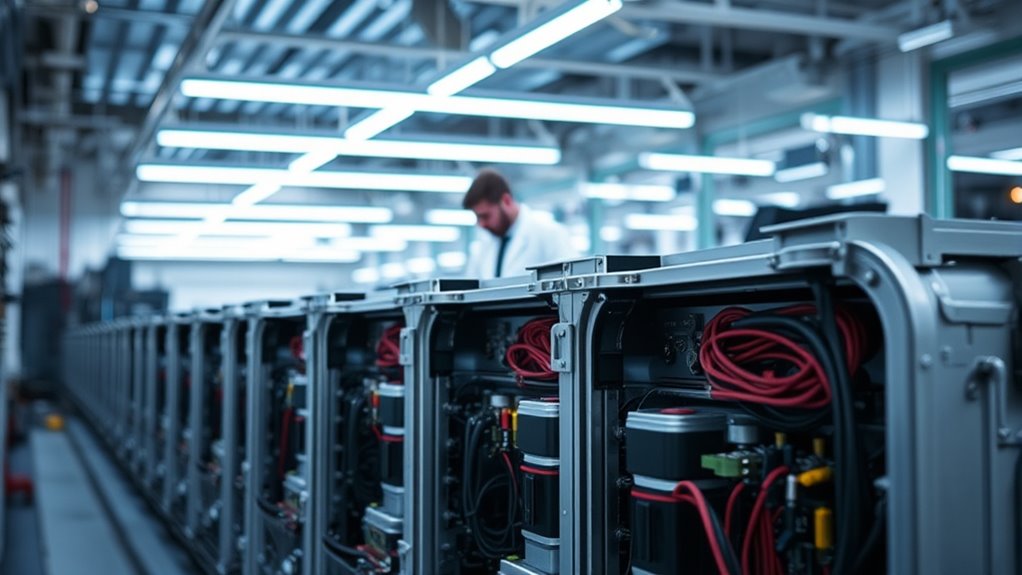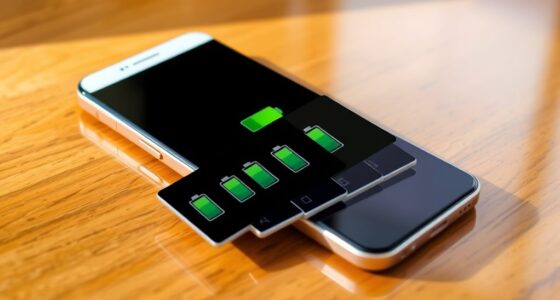Once EV batteries reach the end of their first life in vehicles, they can be repurposed for energy storage. These second-life batteries store excess energy, help manage grid supply, and support renewable sources like solar and wind. This extends their usefulness, reduces waste, and lowers costs. After their second use, batteries are recycled to recover valuable materials. To discover how these repurposed batteries benefit the environment and energy systems, keep exploring further.
Key Takeaways
- EV batteries no longer efficient for vehicle use but still viable for energy storage applications.
- Second-life batteries are repurposed to store renewable energy, improving grid stability and reliability.
- Extending battery lifespan reduces waste, environmental impact, and the need for new battery production.
- After second use, batteries are recycled to recover valuable materials like lithium, cobalt, and nickel.
- Second-life applications support sustainable energy practices and help integrate renewable sources into the grid.

As electric vehicle batteries reach the end of their first life, they often still hold enough capacity to be useful in other applications. Instead of discarding these batteries, many organizations are turning to second-life solutions to extend their usefulness. This approach not only delays the need for battery recycling but also creates opportunities for energy storage that benefits both consumers and the grid. You might be surprised to learn just how versatile these used EV packs can become once they’re repurposed.
Once a battery no longer meets the demands of powering a vehicle efficiently, it doesn’t mean it’s completely useless. Instead, it can be repurposed into energy storage systems. These second-life batteries can store excess energy from renewable sources like solar or wind, helping to balance supply and demand. For example, a used EV pack can be integrated into a home or commercial energy storage system, providing backup power during outages or reducing reliance on the grid during peak hours. This not only increases the overall lifespan of the battery but also reduces the environmental impact associated with manufacturing new storage units. Additionally, advancements in battery performance optimization allow for better utilization of these second-life packs.
Battery recycling is an essential part of this cycle, but it typically happens after the second life is exhausted. Recycling involves breaking down batteries to recover valuable materials like lithium, cobalt, and nickel, which can then be reused in new batteries. Before reaching that stage, however, second-life applications make good use of the remaining capacity. You benefit from this sustainable approach because it maximizes the value extracted from each battery, lowering costs and reducing waste.
Using second-life batteries for energy storage also helps accelerate the adoption of renewable energy. When these batteries are deployed in grid-scale or community projects, they act as buffers, smoothing out fluctuations in power supply. This means you could see cheaper and more reliable renewable energy sources in your area, as the batteries store excess power during sunny or windy days and release it when needed. It’s a smart way to make the most of existing resources, reducing the need for new, resource-intensive battery production.
Frequently Asked Questions
What Is the Typical Lifespan of a Second-Life EV Battery?
You might wonder about the typical lifespan of a second-life EV battery. Usually, these batteries have degraded to about 70-80% of their original capacity, making them suitable for reuse based on specific reuse criteria. Battery degradation varies with usage and conditions, but generally, second-life batteries last around 5-10 years in secondary applications. Proper assessment of degradation levels guarantees they meet the necessary criteria for safe and efficient reuse.
How Do Second-Life Batteries Compare Cost-Wise to New Batteries?
Ever wondered if second-life batteries are truly more economical? You’ll find that they offer significant cost savings compared to new ones, making them an attractive option for many. Their lower upfront costs enhance economic viability, especially for large-scale applications. While they might have slightly reduced capacity, their affordability often outweighs this, providing a smart, sustainable choice for extending battery life and reducing overall energy costs.
Are Second-Life Batteries Environmentally Safer Than New Ones?
You might think second-life batteries are safer environmentally, and they often are, because recycling processes reduce waste and reuse valuable materials. By repurposing EV packs, you lower the environmental impact compared to manufacturing new batteries from scratch. This approach minimizes toxic waste and conserves resources, making second-life batteries a greener option overall. So, choosing them helps protect the environment while extending the life of battery components.
What Are the Main Challenges in Repurposing EV Batteries?
You face challenges in repurposing EV batteries due to battery degradation, which affects performance and capacity. Additionally, the recycling infrastructure isn’t fully developed, making it difficult to efficiently process and reuse old batteries. These issues hinder a seamless shift from used EV packs to second-life applications, requiring improvements in battery testing, refurbishment processes, and recycling systems to ensure safety, reliability, and sustainability in repurposing efforts.
How Does Second-Life Battery Performance Vary Across Different Applications?
When considering second-life battery performance, you’ll notice variations based on the application. In some cases, the batteries handle moderate loads well, maintaining capacity despite battery degradation. In others, high demands cause rapid performance decline. Your success depends on application suitability; lighter tasks like energy storage or backup systems benefit from older batteries, while high-performance needs require fresh or carefully managed packs. Tailoring use guarantees ideal lifespan and efficiency.
Conclusion
Think of second-life batteries as seasoned travelers returning home, ready to explore new adventures. Just like a well-worn backpack still holds treasures, these batteries find fresh purpose, powering homes and grids with resilience. Their journey isn’t over; it’s reborn, proving that with a little care, even tired batteries can continue to serve and inspire. Embrace this cycle—renewed batteries are the legacy of innovation and sustainability in motion.










